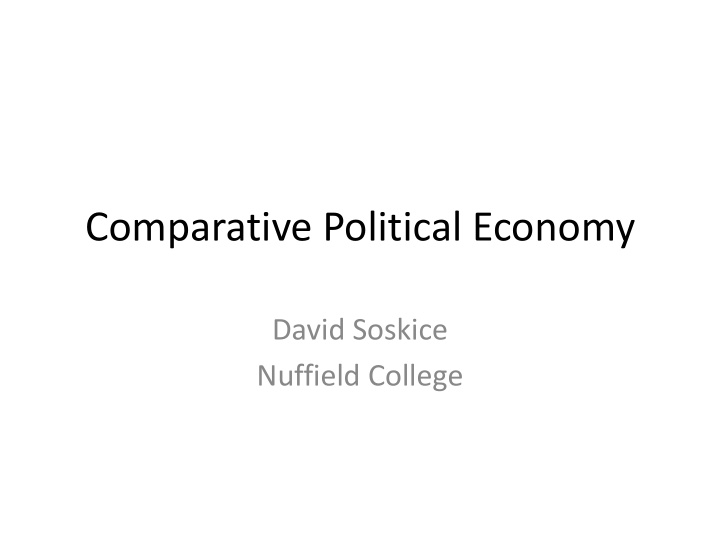



Comparative Political Economy David Soskice Nuffield College
Comparative Political Economy (i) Focus on nation states (ii) Complementarities between 3 systems: Variety of Capitalism (Hall & Soskice) Political System (Lijphart) Welfare State regime (Esping Andersen) (iii) Advanced economies (iv) Two main clusters: Liberal and Coordinated
Types of Political Systems (Lijphart) Competitive: First past post elections Typically two major parties Unilateral right to govern with majority in legislature Leadership parties Consensus: PR elections Several parties Consensus decision-making in many areas Representative parties (often links to interest groups)
Varieties of Capitalism Liberal market economies - Anglo- Coordinated market economies – Saxon: Continental Scandinavian Diffused shareholding. Block shareholding Strong general education system, Strong vocational training at all weak vocational training. levels Regulated labour markets; Flexible labour markets, allowing codetermination, coordinated wage unilateral management control. bargaining, strong unions, employer Weak unions, employer assocs. associations ******* ******* Comparative advantage in rapidly Comparative advantage where moving, high risk, blockbuster experienced skilled responsible product, markets; radical workforces important; incremental innovation innovation
Political System Competitive/ Consensus/PR Majoritarian Sweden, Denmark, Norway, Finland, Coordinated Germany, Austria, Netherlands, Variety of Belgium, Switzerland Capitalism United Kingdom, United States, Liberal New Zealand (1996-) Canada, Australia, Ireland, New Zealand
Types of Welfare State Welfare state dimensions: 1. Insurance (against unemployment, illness); universal v earnings related; [financed either by contributions (typically employers, employees), or from general taxation] 2. Redistribution (holding chance events constant) 3. Public sector provision of child-care, elderly-care v home provision v market provision 4. [Public v private education and health] Esping-Andersen 3 worlds of welfare I Liberal; Anglo-Saxon (safety net): low flat rate “universal”; low redistribution; market provision II Continental: insurance, contribution-financed; ER; low redistribution; home provision III Social Democratic: insurance, universal, general taxation; redistributive; public provision
Political System Competitive/ PLUS WELFARE Consensus/PR STATES Majoritarian (A)Bold Italics: Soc Swed eden en, D Den enmark, Dem Norway, F Finl nland nd , Coordinated Germany, Austria, (B)Bold Underline: Netherlands, Continental Variety of Belgium, Switzerland (C) Plain: Liberal Capitalism United Kingdom, United States, Canada, Liberal New Zealand (1996-) Australia, Ireland, New Zealand
Electoral System and Number of Years with Left of Centre and Right of Centre Governments: 17 Advanced Countries (1945 – 1998) Partisan Spectrum Left of Right of % Right Centre Centre Governments Proportional 342 120 0.26 Representation (8) (9) Electoral System Majoritarian 86 256 0.75 (0) (8)
Some issue areas: Inequality Patterns of economic activity (Innovation, MNCs) Crime and punishment Education and training Corporate governance Industrial relations Gender, work and family Immigration
ECONOMIC AND LITERACY INEQUALITY
COMPARATIVE LITERACY/ NUMERACY PERFORMANCE: 5 th PERCENTILE Prose Document Quantitative Sweden Sw 214.0 218.6 215.9 Nor orway 208.8 202.5 208.9 Nethe herland nds 202.8 202.4 200.9 Germany Ge 199.6 207.2 217.8 Finl nland nd 198.8 189.9 197.1 New ew Z Zea ealand 164.8 153.8 154.1 Ire reland 159.6 146.7 146.2 UK UK 151.2 143.3 141.5 Au Australia 145.1 143.7 149.5 Can anad ada 144.5 133.9 155.1 US US 136.7 125.4 138.3
CRIME AND PUNISHMENT Incarceration rate (per Homicide rate (per 100,000), 100,000), 2006 2006 Liberal economies US 737 5.6 New Zealand 186 2.5 England and Wales 148 1.6 Australia 125 1.9 Coordinated economies Germany 94 1.2 128 (100 in 2002-3) 1.5 Netherlands 82 1.1 Sweden 77 1.0 Denmark 75 2.9 Finland 66 1.1 Norway 62 0.9 Japan [85] [1.7] [France]
60.0 Brazil 99 Chile 98 Colombia 99 55.0 Mexico 98 Peru 97 50.0 Argentina 98 Gini Pre-tax 45.0 Pre-transfer UK 99 USA 00 40.0 Australia 94 France 94 Canada 00 Belgium 97 Germany 00 Sweden 00 35.0 Finland 00 Netherlands 99 Denmark 92 Norway 00 Switzerland 02 30.0 -5.0 0.0 5.0 10.0 15.0 20.0 25.0 30.0 35.0 40.0 45.0 % Redistribution
+ Distributional Redistribution equality (D) (R) Organized labor Equality of Center-left Coordinated Specific assets/ and business governments/ educational wage skill system social policy corporatism distribution bargaining preferences Adoption of PR Coordination of electoral system economic ~1920 activity ~1900 +
Major Issues/ Debates/ Problems (i) Including more societies, and enlarging number of clusters. SE Asia, East Asia, Latin America, Transitional economies, Southern Europe. .... +?? (ii) Historical evolution: if there are two clusters among advanced countries, where did they come from? (iii) Other key institutions: Macroeconomic Demand Management (Monetary, Fiscal, Exchange Rate policy- making and institutions: Liberal cluster discretion-based, Coordinated rule- based. Fed & MPC versus ECB) Legal systems (Common Law in Liberal cluster; Civil Code in Coordinated cluster) Family and social systems
(iv) International relations and international institutions: EU - missing foreign and defence policy International financial coordination, and the crisis (v) Regions, localities (vi) Stability? Globalisation of finance Multinationals Industry to services (vocational training)
Recommend
More recommend